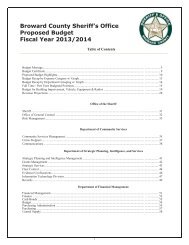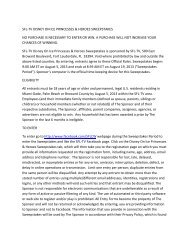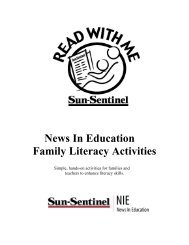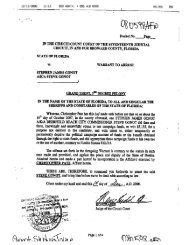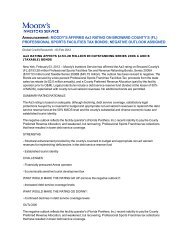Wildfire safety brochures for educators - Volusia County Government
Wildfire safety brochures for educators - Volusia County Government
Wildfire safety brochures for educators - Volusia County Government
You also want an ePaper? Increase the reach of your titles
YUMPU automatically turns print PDFs into web optimized ePapers that Google loves.
Fire in Florida<br />
Over 16 million acres of Florida is covered with <strong>for</strong>ests. Although the<br />
state’s abundant rain and sunshine are vital to the survival of Florida’s <strong>for</strong>ests,<br />
another element is necessary to maintaining them...fire. Over thousands of years,<br />
Florida’s <strong>for</strong>ests have developed because of the presence of fire. In fact, many of<br />
Florida’s ecosystems require fire in order to exist.<br />
Fire has been present since the peninsula known as Florida emerged<br />
from the sea. Prior to the arrival of humans, weather conditions and fuels<br />
determined the occurrence of fires. When the first humans arrived in Florida over<br />
10,000 years ago, their activities provided new ignition sources <strong>for</strong> fire. Along with<br />
periodic natural fires, Native Americans used fire as a tool to shape the<br />
environment and to improve hunting. Lightning fires and fires<br />
set by early humans helped to maintain natural areas<br />
conducive to the growth of herbs, berries, grasses and low<br />
shrubs. Later, when European settlers began colonizing<br />
Florida, they remarked upon the open <strong>for</strong>ests and<br />
grasslands swept clean by fire.<br />
Oxygen<br />
Oxygen is the first component of the fire<br />
triangle. For a fire to burn, the air around it<br />
must be at least 16% oxygen. There<strong>for</strong>e,<br />
Earth’s atmosphere, at about 21%,<br />
provides plenty of oxygen to sustain<br />
a fire. Removing the oxygen, <strong>for</strong><br />
example, by putting dirt on a fire,<br />
smothers it.<br />
Fuel<br />
OXYGEN<br />
FUEL<br />
HEAT<br />
Fire is a self-propagating chemical reaction known<br />
as combustion. It can be defined as rapid<br />
oxidation of a material accompanied by the<br />
release of energy in the <strong>for</strong>m of heat and light. To<br />
have fire, three ingredients are needed: oxygen,<br />
heat and fuel. These 3 elements are known<br />
as the fire triangle. Removing any of these<br />
three ingredients, will extinguish a fire.<br />
Heat<br />
Heat is a second component of the fire triangle.<br />
Heat and temperature are closely related. Heat<br />
is the energy of molecules that have been<br />
excited into faster motion, while temperature<br />
is a measure of the magnitude of this<br />
molecular activity. In order <strong>for</strong> ignition to<br />
occur, plant material must be heated to<br />
the point where volatile compounds,<br />
or about 655 +/- 72 degrees F (346<br />
+/- 40 degrees C). The heat<br />
necessary to ignite a fire can<br />
come from many different<br />
sources, including human<br />
carelessness and<br />
lightning.<br />
Fuel is the third side of the fire triangle. Fuel is any material capable of burning. In Florida, ty pically wildland fuels include litter (e.g., pine straw,<br />
dead leaves, twigs), grasses (e.g., wiregrass, cogon grass), shrubs (e.g., saw palmetto, gallberry), and trees (e.g., pine trees). Thus, the fuels in<br />
a Florida <strong>for</strong>est would include dried and dead materials, such as branches, grasses, leaves, and pine needles, as well as living grasses and<br />
shrubs, such as palmetto and gallberry and young pines. Many fire adaptive plants in Florida contain volatile resins that encourage fire spreads<br />
through the ecosystem. Human structures can also become fuel <strong>for</strong> fire. It is important to understand that fire does not discriminate between<br />
different types of fuels: fire will burn any available combustible material in its path.
Smokey gets Puzzled<br />
Word Scramble<br />
Find the following words:<br />
BURNS<br />
COSTLY<br />
DAMAGE<br />
EVACUATION<br />
HOUSE<br />
INJURES<br />
TREES<br />
WILDLIFE<br />
D Q P S C Q J O J N C S Q M E<br />
O K W A S Y P E O O I D E V S<br />
K D O A F T E I S B O M P E U<br />
F R W C S W T T K H B M D C O<br />
S Y G Q O A L I W L I X A V H<br />
Y E W H U Y Z V N L F R M N A<br />
S P E C V O C S B J J O A D P<br />
P L A R R M L M Z M U A G K R<br />
E V U T T Z N H Y L K R E B P<br />
E Y U P E W I L D L I F E Y U<br />
S N R U B X T B C B C U W S E<br />
A O J L X X N Q Q C C Q O V P<br />
J X G B A I I I G R C N C F V<br />
T O T R Z Y M B J G N J O S E<br />
K N T H Q M D Q J B H Y I S A<br />
ARSON<br />
ALERT!<br />
Hey kids , if you see<br />
anyone setting fires<br />
on purpose, tell your<br />
parents to call the<br />
Arson Alert Hotline!<br />
1-800-342-5869<br />
Mom & Dad can get up<br />
to a $5,000 reward<br />
<strong>for</strong> in<strong>for</strong>mation leading<br />
to an arrest.<br />
Crossword<br />
Across<br />
2. A woods fire that is<br />
out of control<br />
7. Aircraft used to drop<br />
water on a wildfire<br />
9. Ideas that can<br />
reduce wildfire risk<br />
Down<br />
1. These are destroyed when<br />
a wildfire gets too close<br />
3. Type of space that keeps a<br />
wildfire away from your home<br />
4. A fire that is used to keep<br />
vegetation under control<br />
5. The wildfire fighting bear<br />
6. Intentionally starting a wildfire<br />
to cause damage<br />
8. Number of feet of defensible<br />
space homes should have
Fire in Florida’s Ecosystem<br />
Fire and water are among the primary<br />
<strong>for</strong>ces shaping Florida’s landscape. As<br />
Florida’s climate changed over the eons,<br />
plant and animal species became adaptive.<br />
Some of Florida’s species provide clear<br />
examples of adaptations to fire. For example,<br />
southern pine trees have thick bark that<br />
insulates the inner, living tissue from fire’s<br />
heat. Longleaf pine is so fire resistant that<br />
mature trees usually escape the injurious<br />
effects of low-level fire and become seed<br />
trees <strong>for</strong> the re<strong>for</strong>estation of new openings in<br />
the burned area. The Ocala sand pine<br />
exhibits another adaptation <strong>for</strong> coping with<br />
fire: the “serotinous” cones remain closed<br />
until a fire’s intense heat opens the cones<br />
and allows the seeds to fall on fresh soil<br />
exposed by the passing fire. Seeds of many<br />
plants grow best under the conditions<br />
created by fire—exposed mineral soil,<br />
increased nutrients provided by ash, and<br />
open areas with plenty of sunlight.<br />
Animal life also depends on fire. The<br />
gopher tortoise, whose burrows provide<br />
habitat or shelter <strong>for</strong> hundreds of other<br />
species, is dependant on periodic fire to<br />
provide fresh browsing vegetation. Without<br />
fire, the scrub habitat changes; in overgrown<br />
scrub, plants create so much shade and leaf<br />
litter that the open, sandy patches disappear<br />
and so do the species that prefer them.<br />
Canopy closure reduces or eliminates habitat<br />
<strong>for</strong> Florida mice, pygmy mole crickets, scrub<br />
lizards, and sand skinks. Overgrown oaks<br />
produce fewer acorns <strong>for</strong> animals such as<br />
Florida scrub-jays, Florida mice, black bear<br />
and acorn weevils. The threatened Florida<br />
scrub-jay requires areas with open pine<br />
cover (less than 15%), where pine densities<br />
is kept low by frequent understory fires. The<br />
best vegetation <strong>for</strong> the jays consists of<br />
mosaic of different age classes of scrub,<br />
A native burrowing gopher tortoise<br />
most of which have burned within the last 20<br />
years. Without fire, the oaks become too tall<br />
and the habitat too dense <strong>for</strong> the Florida<br />
scrub-jay because predators are not easily<br />
seen.<br />
A native Florida scrub-jay<br />
Photo: Arnold’s Wildlife Rehabilitation Center, Okeechobee, FL
The endangered red-cockaded<br />
woodpecker (Picoides borealis) inhabits<br />
longleaf as well as loblolly and shortleaf pine<br />
<strong>for</strong>ests. Understory fires are essential to<br />
prevent the development of hardwood midstory<br />
growth; without such fires, these birds<br />
will abandon their territory. Red-cockaded<br />
woodpeckers today are found predominantly<br />
in areas with a history of aggressive,<br />
prescribed burning. In addition, understory<br />
burning increases populations of<br />
arthropods—many of which breed and feed<br />
in charred trees—likely aiding insectivorous<br />
loggerhead shrikes (Lanius ludovicianus)<br />
and American kestrels (Falco sparverius).<br />
During a fire, many species of small<br />
animals, such as ants, Florida mice, gopher<br />
frogs, mole crickets, and ox beetles, have<br />
ways to flee, or find refuge in an existing<br />
(gopher tortoise) burrow beyond the reach of<br />
the heat. Birds can easily fly away from the<br />
flames. Larger mammals, can often sense<br />
and easily out maneuver a fire.<br />
Infrequent, devastating, high-intensity<br />
fires may destroy the tree canopy but they<br />
allow sunlight to bathe the <strong>for</strong>est floor and<br />
aid in the regrowth of new plants. These hot<br />
fires leave behind a nutrient-rich ash that<br />
feeds the new plants as they re-sprout. Since<br />
most surface vegetation is burned away, little<br />
or no competition <strong>for</strong> nutrients exists so<br />
young pine seedlings are able to establish<br />
easily and grow quickly. Scrub habitat<br />
regenerates rapidly after most fires. Larger<br />
mammals, such as deer love to eat the fresh<br />
regeneration of grass that occurs after a fire.<br />
The new grass buds that grow immediately<br />
after a fire are known as “ice cream species”<br />
of grass; they are the favorite grass <strong>for</strong> deer<br />
to eat. As the majority of a Florida panther’s<br />
diet consists of deer, any management<br />
activity that improves the deer population<br />
also improves the panther population.<br />
A wild Florida egret feasts on insects<br />
as the bugs flee the nearby fire.<br />
New life out of the ash, just a few days<br />
after a fire.<br />
A native Florida Key Deer
Prescribed Burning<br />
Now that we realize that many of Florida’s native species will disappear unless fire is introduced b ack into the habitats, people in<br />
charge of preserving and maintaining natural areas are including prescribed burns as part of their m anagement. Prescribed burns are<br />
intended to do three things: 1) mimic natural conditions, 2) maintain a variety of plant communities, and 3) decrease the amount of<br />
accumulated plant material, and thereby reduce the chance of devastating wildfires. A prescribed burn is not a one-time event, but a<br />
process that must be continually applied to the landscape.<br />
Fire provides a coming-out party, complete with charcoal. The corollary principle is that, in the ab sence of fire, these plant<br />
species—and their animal dependents—may eventually become absent themselves.<br />
Only in the last century has fire in the <strong>for</strong>est been viewed as a monster. We are now beginning to re alize that<br />
fire is a natural agent essential <strong>for</strong> maintaining the natural ecosystems of Florida. Fire is neither all good nor all<br />
bad. It is natural. It is powerful. In the proper places, in the right hands, at the right times, fi re can be an asset<br />
and an ally. To employ fire as a useful friend is much more logical than confronting if as an enemy.
Florida Division of Forestry<br />
The Florida Division of Forestry (FDOF)<br />
was founded in 1927 in response to<br />
uncontrolled wildfires that burned during the<br />
1920s. The FDOF has the responsibility to<br />
prevent, detect, suppress and extinguish<br />
wildfires wherever they occur within Florida.<br />
The FDOF per<strong>for</strong>ms wildfire prevention through<br />
education and wildfire hazard mitigation<br />
programs. The agency also per<strong>for</strong>ms wildfire<br />
suppression (firefighting), management of 35<br />
state <strong>for</strong>ests totaling about 1,000,000 acres,<br />
urban and community <strong>for</strong>estry assistance, and<br />
FDOF Fire Spotting<br />
<strong>for</strong>estry assistance to private landowners.<br />
The FDOF relies heavily on federal, state,<br />
and local partners to fulfill its statutory<br />
responsibility <strong>for</strong> wildfire prevention and<br />
suppression. Mutual aid agreements throughout<br />
the state mean the county and/or municipal fire<br />
trucks frequently respond along with a FDOF<br />
firefighting unit. Although some fire lookout<br />
towers are still staffed on a seasonal basis,<br />
most wildfires in Florida are now reported by<br />
FDOF patrol aircraft or citizens who call 911.<br />
Florida Division of Forestry airplane fleet consists of 20 single-engine (Piper and Cessna)<br />
and 2 light twin-engine (Piper Navajo) airplanes. These airplanes are used to scout out<br />
wildfires and serve as “eyes in the sky” <strong>for</strong> firefighters on the ground. Smoke impedes ground<br />
crews and the airplanes circles the fire communicating to them hazards and fire weather.<br />
A fire lookout tower, fire tower or lookout<br />
tower, provides housing and protection <strong>for</strong> a person<br />
known as a “fire lookout” whose duty it is to search<br />
<strong>for</strong> fire in the wilderness. The fire lookout tower or<br />
view shed, is a small building usually located on a<br />
high vantage point in order to maximize the viewing<br />
distance and range. From this vantage point, the fire<br />
lookout can see any trace of smoke that may<br />
develop, determine the location by using a device<br />
known as an Alidade, and call fire suppression<br />
personnel to the fire.
Specialized Equipment <strong>for</strong> Florida’s <strong>Wildfire</strong>s<br />
The Division of Forestry accomplishes its Mission to safeguard the lives and property of Florida’s c itizens by combining a unique array of<br />
equipment that enables it to attack wildfire and respond to other emergent needs—no matter what the terrain or location. This equipment<br />
also permits the Division to carry out our other land management responsibilities on public and priv ate lands. The Division of Forestry has a<br />
long and distinguished record of af<strong>for</strong>ding the citizens and leaders of this state the peace of mind that they and their loved ones and<br />
properties are safe from the effects of wildfires and other calamities.<br />
The Medium Crawler Tractor is the Division’s primary on-theground<br />
firefighting piece of equipment. The tractors can plow down to<br />
mineral soil creating a 8’-10’ wide fire break in most vegetation types in<br />
Florida. The tractor removes the fuel element of the fire triangle thus<br />
stopping an oncoming wildfire be<strong>for</strong>e it can reach homes, property and<br />
resources. The Medium Crawler Tractor enables the wildland firefighters<br />
to reach deep into the woods to suppress fires that are inaccessible by<br />
other means. It is also used as a preventative management tool to assist<br />
landowners by scraping fire breaks on their land be<strong>for</strong>e a fire occurs and<br />
in preparation <strong>for</strong> prescribed burning. This size tractor has been used very<br />
effectively <strong>for</strong> clearing roads and yards following Hurricanes Andrew and<br />
Wilma, and other weather events.<br />
The helicopter fleet consists of seven medium (Bell UH1-H and<br />
209) and two light (Bell OH-58) <strong>for</strong>mer military helicopters. Three B-209<br />
“FireSnake” helicopters (demilitarized AH-1P “Cobra” attack helicopters)<br />
are used by DOF <strong>for</strong> fire suppression. These high-speed aircraft can carry<br />
a 320 gallon bucket or a foam-injection equipped 360 gallon fixed tank to<br />
drop water or foam on fires. Four UH-1H “Huey” or “SuperHuey”<br />
helicopters in the DOF fleet drop up to 300 gallons of foam or water,<br />
transport up to 10 firefighters, or aerially ignite prescribed burns. OH-58A+<br />
“Kiowa” light helicopters. They are used largely <strong>for</strong> aerial ignition<br />
prescribed burning, tactical counterfire, and observation, but also can<br />
carry a 75 gallon water bucket <strong>for</strong> fire suppression.<br />
The Brush Patrol (Wildland Fire Engine) is used <strong>for</strong> deep woods penetration in the direct<br />
suppression of wildfires and to protect structures in the wildland/urban interface. The Brush<br />
Patrol is also used as a standby unit during prescribed burning <strong>for</strong> landowners who utilize DOF<br />
assistance programs, and <strong>for</strong> prescribed burning on state land. These special pumper units are<br />
fabricated at our Central Shop to meet our special firefighting requirements.
PPE: Personal Protective Equipment<br />
Division of Forestry firefighters are equipped with special gear<br />
to keep them safe while fighting fires. This gear is called PPE.<br />
1<br />
Wildland Helmet – A lightweight, plastic helmet is<br />
designed to protect the head from blows and also offer some<br />
protection from the heat and flames.<br />
1<br />
2<br />
2<br />
Eye protection – Wildland Firefighters can wear a visor<br />
or <strong>safety</strong> goggles; these help to protect the wildland<br />
firefighter’s eyes from smoke, dust, and small flying objects.<br />
3<br />
3<br />
Protective Clothing – All personnel are required to<br />
wear “Nomex” protective clothing on all fire operations.<br />
Aramid fabric type two is fire-resistant, not fireproof. This is a<br />
durable fabric that provides good thermal protection. It will<br />
burn when exposed to flames, but stops burning when flames<br />
are removed. Instead of melting or burning to ash, it <strong>for</strong>ms a<br />
char that helps protect skin. The yellow color is more visible in<br />
dark and smoky environments.<br />
5<br />
4<br />
4<br />
Gloves – Leather or Nomex gloves are designed to protect<br />
hands against blisters, cuts, scratches, and minor burns<br />
during fire operations.<br />
5<br />
Fire Shelter – It is the most important component of a<br />
wildland firefighter’s personal protection equipment. A fire<br />
shelter is a <strong>safety</strong> device of last resort used by wildland<br />
firefighters when trapped by wildfires. It is designed to reflect<br />
radiant heat, protect against convective heat, and trap<br />
breathable air in an attempt to save the firefighter’s life.<br />
The fire shelter fits inside a box and is worn on the wildfire<br />
fighter’s belt.<br />
6<br />
6<br />
Leather Boots – All boots <strong>for</strong> wildfire suppression and<br />
field work are required to be leather lace-up boots with an<br />
eight-inch minimum height.<br />
7<br />
7<br />
Radio – A radio is an essential component to ensure<br />
effective communication.
Wildland Urban Interface<br />
Over the past fifty years, more and more Floridians have moved out of the cities to build homes and businesses in the outlying fringe areas<br />
known as the wildland urban interface. In fact, almost one-third of our population lives in these in terface areas where structures intermingle<br />
with <strong>for</strong>ests and wildlands. Residents here, however, usually don’t realize they may live too “close to nature,” they may, in fact, be living on<br />
the edge of a wildland fire disaster. When dry years come, Florida experiences severe wildfires—wild fires that destroy homes, disrupt<br />
people’s lives and impact our economy.<br />
Why homes burn Wildland Urban Interface homes are usually lost because of the “little things”<br />
associated with the two most vulnerable parts of a home: the roof and the area immediately surroundi ng the structure.<br />
The most vulnerable part of the house is the roof and soffits. Wood shingles can easily catch fire f rom flying fire brands. Roofs with fire<br />
resistant shingles can also catch fire from embers if there is an accumulation of leaves and pine ne edles on the roof and in the gutters.<br />
Exposed eaves can allow fire brands into the attic and catch the roof on fire. Vinyl soffits are not recommended in fire prone areas unless<br />
they have backing of 1/8’’ noncombustible (wire) mesh. They melt easily and can allow fire brands in to the attic area.
When <strong>Wildfire</strong><br />
Threatens<br />
Should your house be threatened by wildfire, you<br />
may be advised to evacuate by a fire or law<br />
en<strong>for</strong>cement official. Do not try to fight the fire<br />
yourself if you have been asked to evacuate the area.<br />
Protect Your Family<br />
Evacuate all family members as well as pets.<br />
Include special items needed <strong>for</strong> infant, elderly or disabled<br />
family members and pets.<br />
Contact a friend or relative and rely your plans of where<br />
you are going.<br />
Tune into a local television or radio station and listen <strong>for</strong> updates and instructions.<br />
Place valuable papers and mementos in the car.<br />
Wear protective clothing- sturdy shoes, cotton, or woolen clothing, long pants, a long sleeved shirt , gloves and a handkerchief<br />
to protect your face.<br />
Choose a route away from fire hazards. Watch <strong>for</strong> changes in the speed and direction of fire and smok e.<br />
If you have time be<strong>for</strong>e you evacuate take these steps to protect your home:<br />
Protect the Exterior of your home<br />
Close all exterior doors and windows.<br />
Place combustible patio furniture in the house or garage.<br />
Shut off propane at the tank or natural gas at the meter.<br />
Make sure all garden hoses are connected to faucets and attach a nozzle set on “spray.”<br />
Fill trash cans and other containers with water. Soak rags, towels or small rugs with water to use i n beating out embers or small fires.<br />
Consider placing lawn sprinkler on the roof if water pressure is adequate. Do not turn on water unti l burning embers begin to land<br />
on the roof in order to conserve the water supply.<br />
Wet or remove shrubs within fifteen feet of the home.<br />
Protect the interior of your home<br />
Close all interior doors.<br />
Leave a light on in each room to increase the visibility of your home in heavy smoke.<br />
Remove lightweight and/or non-fire resistant curtains and other combustible materials from around wi ndows.<br />
If available, close fire resistant drapes, shutters or Venetian blinds.<br />
Turn off all pilot lights.<br />
Move flammable furniture into the center of the home, away from windows and sliding glass doors.
Smokey Bear’s<br />
Firewise MAZE<br />
Help the wildland<br />
and structure<br />
firefighters save<br />
this home.<br />
Homeowner <strong>Wildfire</strong> Safety Check List<br />
1. Roof Cleaned of Debris<br />
2. Gutters Cleaned<br />
3. Two Escape Routes<br />
4. Family <strong>Wildfire</strong> Plan<br />
5. Cleared Access to Home<br />
6. Address Clearly Marked<br />
7. Prune Tree Limbs<br />
8. Firewood Stored Away from Home<br />
9. Combustible Materials Away from Home<br />
10. Defensible Space (At Least 30 feet)<br />
11. Have an Outside Water Source<br />
12. Less Flammable Landscaping<br />
30 feet of defensible<br />
space from woods<br />
✔Yes No<br />
Start Finish
Working Together <strong>for</strong> a Common Goal<br />
Response to wildfires in the State of Florida is primarily a partnership<br />
ef<strong>for</strong>t between the Division of Forestry and local fire agencies. Frequently,<br />
when a fire emergency occurs, the notification is processed through the local<br />
911 emergency phone system or Division of Forestry detection. The local fire<br />
department responds and the Division of Forestry is notified. As the first<br />
responder, the local department may arrive on scene first and determine the<br />
need <strong>for</strong> <strong>for</strong>estry resources to continue. In a true wildfire situation, the Division<br />
of Forestry, or the appropriate federal agency on federal property, may be<br />
dispatched and arrive first and determine the need <strong>for</strong> additional resources.<br />
The Division of Forestry has statutory responsibility <strong>for</strong> all wildfires within<br />
the State of Florida. Local fire agencies have responsibility <strong>for</strong> fire protection<br />
within their jurisdictional boundaries. Using the National Incident Management<br />
System (NIMS) model, the first arriving agency assumes command of the<br />
incident. Command is then transferred as necessary as additional units or<br />
agencies arrive on the scene. In a working incident, the primary agency having<br />
responsibility <strong>for</strong> the fire will assume command of the operation after their<br />
arrival. When fires involve the interface between the wildland areas and the<br />
urban and suburban communities, there is joint responsibility to combat the<br />
spread of these fires by both the local agencies and the Division of Forestry.<br />
In these cases, all agencies must work together and support each other in a<br />
unified command operation to provide the most efficient use of resources.<br />
On a wildfire, there could be over a hundred people working on one fire.<br />
Not all personnel are firefighters. There are dispatchers, media experts,<br />
mechanics, accountants, meteorologists, police, local experts (on land, fuel,<br />
terrain, waterways, so on), electrical and infrastructure experts and many more<br />
specialized individuals depending on the fire.
Florida’s State Forests<br />
A state <strong>for</strong>est is an area of land that has trees growing in wild settings and is managed by the Flor ida Division of Forestry. The Division of<br />
Forestry tends over 35 state <strong>for</strong>ests totaling over 1,000,000 acres across Florida, from Naples to Ja cksonville to Pensacola and everywhere<br />
else in between. Many different people work on our state <strong>for</strong>ests, including <strong>for</strong>esters, biologists, p ark rangers, and <strong>for</strong>est rangers to make<br />
sure that the <strong>for</strong>ests continue to be well tended and healthy. State <strong>for</strong>ests provide recreation <strong>for</strong> v isitors with camping and horseback riding,<br />
homes and food <strong>for</strong> wildlife, clean drinking water, and trees to make paper and other products.<br />
Facts about Florida’s Forests<br />
For every tree that is cut down, five new seedlings are planted in<br />
the state of Florida.<br />
More than 82 million trees are planted each year in Florida. This<br />
ranks Florida as 4th in the country in number of trees planted<br />
each year.<br />
Since 1980, over 1.3 million acres of <strong>for</strong>est have been converted<br />
to houses, factories, or other uses. That’s 1200 acres each week,<br />
or about two square miles. Still, 50% of Florida’s land area is<br />
covered in <strong>for</strong>ests.<br />
Over 5,000 products that we use start from a tree. The list<br />
includes: bandages, crayons, football helmets, gum, ink, money,<br />
nuts, paint, and paper. Imagine your life without these products!<br />
Trees, just like people, live <strong>for</strong> different amounts of time. A live<br />
oak in Florida can live <strong>for</strong> over 300 years whereas a pine tree will<br />
usually live about 80 years.<br />
Within 3 years of harvest, a new <strong>for</strong>est is started. In some cases,<br />
trees are left to provide seeds <strong>for</strong> new seedlings, or seedlings can<br />
be planted. Cypress trees can grow from the stumps of the trees<br />
that were cut down.<br />
Foresters examine trees to look <strong>for</strong> good growth, insects,<br />
diseases, and needs <strong>for</strong> fertilizer.<br />
In an average year, 189,000 acres of trees are harvested.<br />
Different methods are used to harvest the trees, including:<br />
thinning (removing some trees to leave remaining trees with more<br />
room to grow); clear-cut (starting over with a new <strong>for</strong>est); and<br />
seed tree (scattered trees are left to provide seed to start the next<br />
<strong>for</strong>est). In the end, new trees are started or planted.<br />
In cities, the average age that a tree lives is only 7 years because<br />
of the packed soil and limited rooting space. A tree’s roots usually<br />
extend beyond the drip-line of the tree’s branches. Trees need<br />
space to grow and in order to live longer!<br />
In Florida, big equipment is used to harvest trees from the<br />
<strong>for</strong>est to transport them to the mills where paper and lumber<br />
are made.
The History of the<br />
real Smokey Bear<br />
Smokey rescued<br />
Did you know that the real Smokey Bear was an actual baby black bear that was found<br />
alone, charred, and scared after a devastating wildfire burned through New Mexico? One spring<br />
day in 1950 in the Capitan Mountains of New Mexico, an operator in one of the fire<br />
towers to the north of the Capitans spotted smoke and called the location into the<br />
nearest ranger station. The first crew discovered a major fire being swept along the<br />
ground between the trees, driven by a strong wind. Word spread rapidly and more<br />
crews reported to help. Forest Rangers, Army soldiers, men from the New Mexico<br />
State Game Department, and civilian volunteers worked together to gain control of the<br />
raging fire. As soon as they contained the fire to one spot, the wind would push it<br />
across the lines. During one of the lulls in firefighting, a report of a lonely bear cub who<br />
had been seen wandering near the fireline was reported. The men left him alone<br />
because they thought the mother bear might come <strong>for</strong> him. Several soldiers were caught<br />
directly in the path of the fire storm, barely escaping by laying face down on a rockslide <strong>for</strong><br />
over an hour until the fire had burned past them. In spite of the experience, the firefighters<br />
were safe except <strong>for</strong> a few scorches and some burned holes in their clothes.<br />
Nearby, the little cub had been caught in the path of the same fire and had not fared<br />
as well. He had taken refuge in a tree that was now nothing but a charred smoking snag. His<br />
climb had saved his life but left him badly burned on the paws and hind legs. The soldiers<br />
removed the little bear cub from the burned tree, but they did not know what to do with him. A<br />
rancher, who had been helping the firefighters, agreed to take the cub home. A New<br />
Mexico Department of Game and Fish Ranger heard about the cub when he returned<br />
to the fire camp and drove to the rancher’s home to get the bear. The cub needed<br />
veterinary aid and was flown in a small plane to Santa Fe where the burns were<br />
treated and bandaged. The news about the little bear spread swiftly throughout New<br />
Mexico. Soon the United Press and Associated Press picked up the story and<br />
broadcast it nationwide. Many people wrote or called to inquire about the little bear’s<br />
progress. The State Game Warden wrote an official letter to the Chief of the Forest<br />
Service, presenting the cub to the agency with the understanding that the small<br />
bear would be dedicated to a publicity program of fire prevention and conservation.<br />
The go-ahead was given to send the bear to Washington, D.C., where he found a<br />
home at the National Zoo, becoming the living symbol of Smokey Bear.
Enter today!<br />
With help from your parent or teacher, take our <strong>Wildfire</strong> Safety Quiz<br />
at www. f l - dof.com/wildfire_<strong>safety</strong>.pdf . Print out the<br />
quiz, and answer the five questions. Give your finished quiz to your<br />
teacher. A Florida Division of Forestry representative will collect the<br />
quizzes from your school and grade them. Everyone scoring 100%<br />
on the quiz will be entered into a countywide drawing!<br />
Odds <strong>for</strong> winning are good, so enter today!<br />
Grand Prize Winner! Win a visit from a Florida<br />
Division of Forestry Ranger, who will bring his equipment and<br />
visit your class to talk about fires and fire <strong>safety</strong>. The student<br />
winner will be named “Ranger <strong>for</strong> the Day” and will receive a<br />
certificate, ranger hat and Smokey Bear watch!<br />
Win a visit/presentation by Florida Division of Forestry<br />
Ranger, be named “Ranger <strong>for</strong> the Day,” receive<br />
certificate, ranger hat and Smokey Bear backpack!<br />
Win a visit/presentation by Florida Division of Forestry Ranger,<br />
be named “Ranger <strong>for</strong> the Day,” receive certificate, ranger hat<br />
and Smokey Bear Fire Patrol t-shirt!<br />
Florida Division of Forestry www.fl-dof.com<br />
Everglades District<br />
561-791-4725<br />
Monroe, Dade, Broward<br />
& Palm Beach Counties<br />
Okeechobee District<br />
772-467-3008<br />
Martin, St. Lucie, Indian River,<br />
Okeechobee, Highlands<br />
& Glades Counties<br />
Caloosahatchee District<br />
239-690-3500<br />
Lee, Collier<br />
& Hendry Counties<br />
Myakka District<br />
941-727-6481<br />
Charlotte, DeSoto, Hardee, Manatee<br />
& Sarasota Counties<br />
Teachers! The Florida Division of Forestry offers many educational<br />
items FREE to you! Go to www.fl-dof.com <strong>for</strong> more in<strong>for</strong>mation.



